Organizational Behavior Report: Challenges and Theories at Next PLC
VerifiedAdded on 2020/01/07
|14
|4843
|168
Report
AI Summary
This report provides an analysis of organizational behavior within Next PLC, a multinational clothing and home products retailer. The report delves into the challenges of workforce diversity, identifying symptoms such as employee frustration and the impact of negative factors on work quality. It explores the application of various theories, including scientific leadership, human relations, decision-making, systems, and Neo Human Relations School, to address these issues. The comparative analysis theory is utilized to understand how Next PLC can analyze workforce diversity. The report highlights how the company adapts to changes, fosters communication, and leverages scientific leadership to provide solutions. The report also provides evidence of the theories' effects on communication and structure within the organization. Overall, the report aims to provide a comprehensive understanding of organizational behavior and its implications for Next PLC.
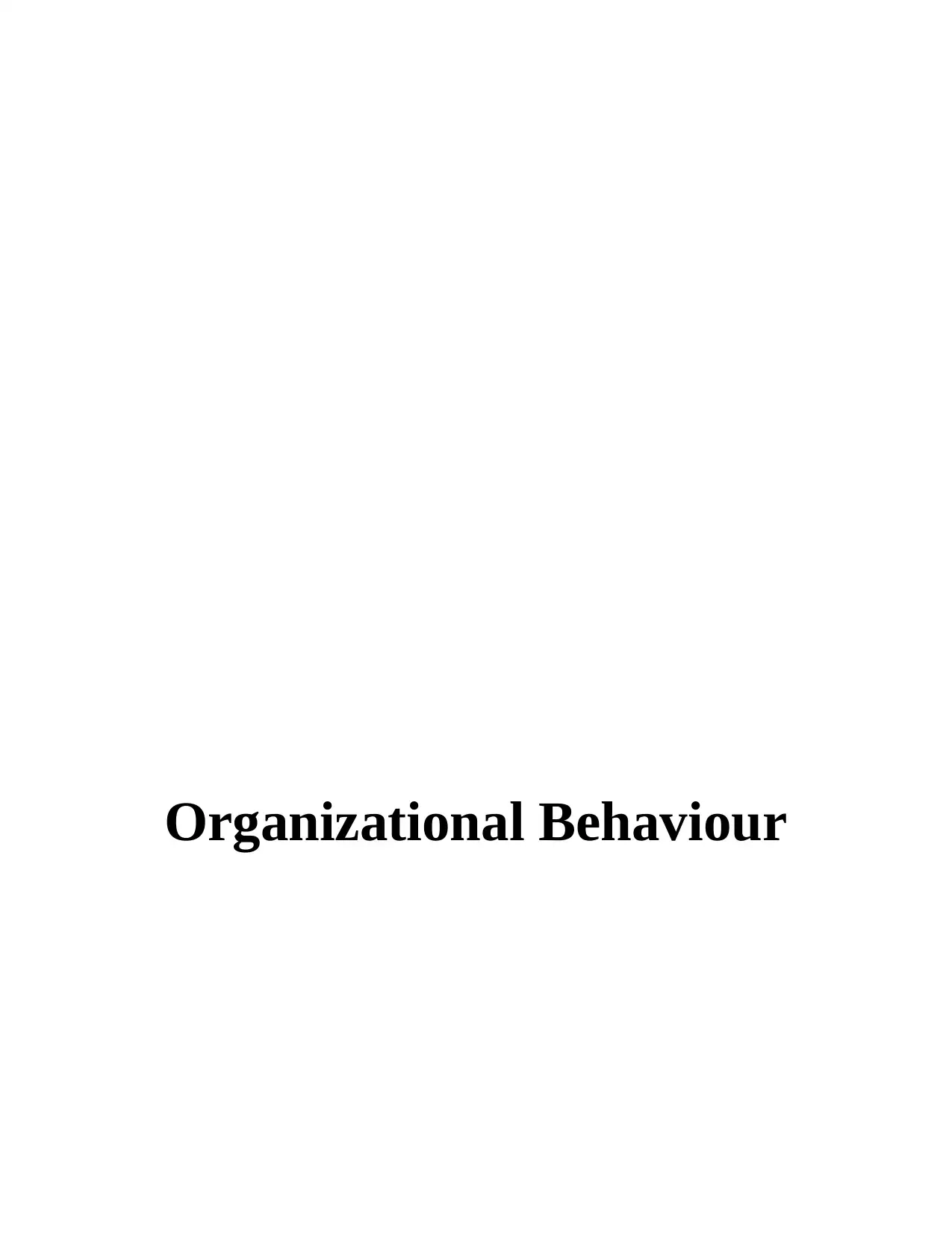
Organizational Behaviour
Paraphrase This Document
Need a fresh take? Get an instant paraphrase of this document with our AI Paraphraser
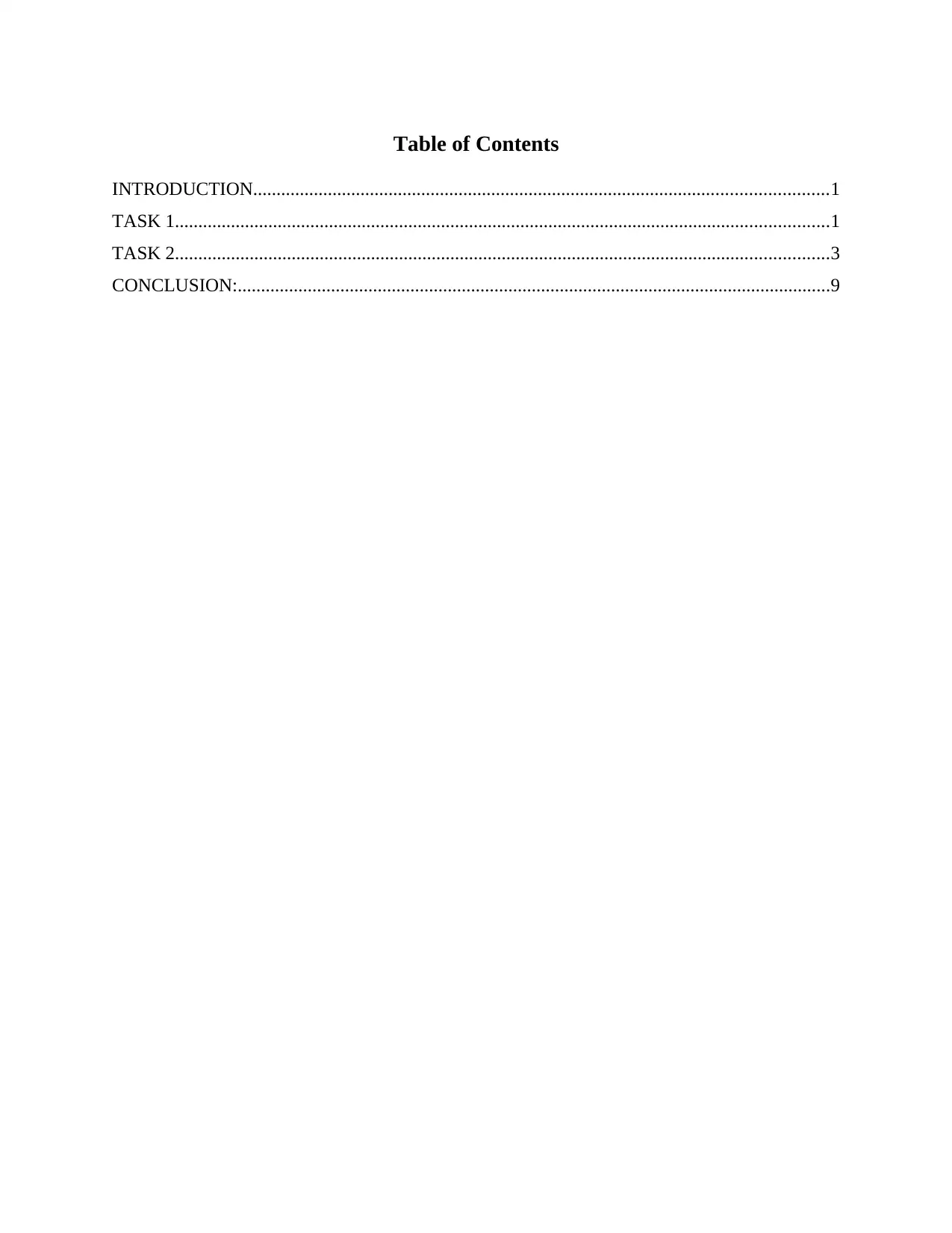
Table of Contents
INTRODUCTION...........................................................................................................................1
TASK 1............................................................................................................................................1
TASK 2............................................................................................................................................3
CONCLUSION:...............................................................................................................................9
INTRODUCTION...........................................................................................................................1
TASK 1............................................................................................................................................1
TASK 2............................................................................................................................................3
CONCLUSION:...............................................................................................................................9
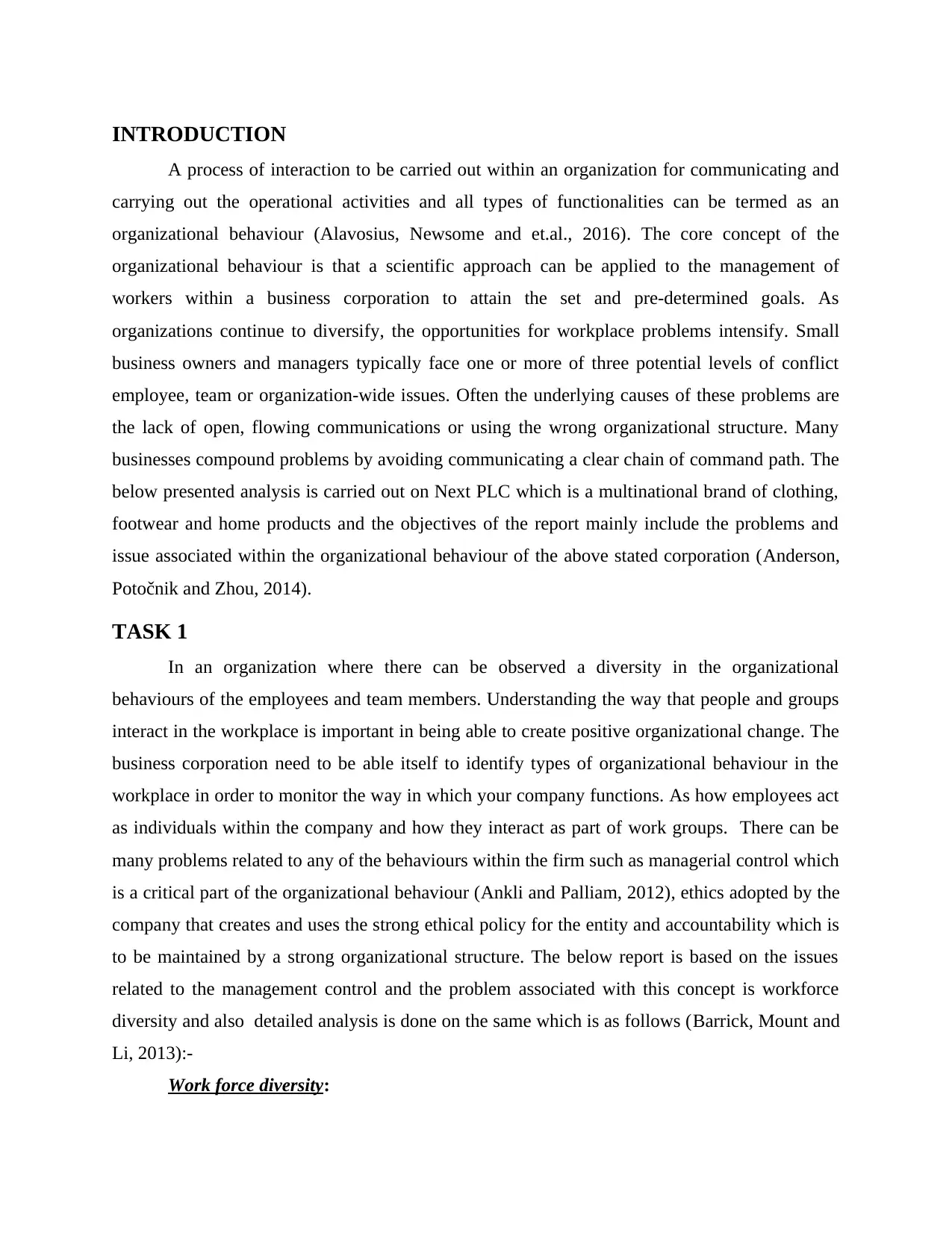
INTRODUCTION
A process of interaction to be carried out within an organization for communicating and
carrying out the operational activities and all types of functionalities can be termed as an
organizational behaviour (Alavosius, Newsome and et.al., 2016). The core concept of the
organizational behaviour is that a scientific approach can be applied to the management of
workers within a business corporation to attain the set and pre-determined goals. As
organizations continue to diversify, the opportunities for workplace problems intensify. Small
business owners and managers typically face one or more of three potential levels of conflict
employee, team or organization-wide issues. Often the underlying causes of these problems are
the lack of open, flowing communications or using the wrong organizational structure. Many
businesses compound problems by avoiding communicating a clear chain of command path. The
below presented analysis is carried out on Next PLC which is a multinational brand of clothing,
footwear and home products and the objectives of the report mainly include the problems and
issue associated within the organizational behaviour of the above stated corporation (Anderson,
Potočnik and Zhou, 2014).
TASK 1
In an organization where there can be observed a diversity in the organizational
behaviours of the employees and team members. Understanding the way that people and groups
interact in the workplace is important in being able to create positive organizational change. The
business corporation need to be able itself to identify types of organizational behaviour in the
workplace in order to monitor the way in which your company functions. As how employees act
as individuals within the company and how they interact as part of work groups. There can be
many problems related to any of the behaviours within the firm such as managerial control which
is a critical part of the organizational behaviour (Ankli and Palliam, 2012), ethics adopted by the
company that creates and uses the strong ethical policy for the entity and accountability which is
to be maintained by a strong organizational structure. The below report is based on the issues
related to the management control and the problem associated with this concept is workforce
diversity and also detailed analysis is done on the same which is as follows (Barrick, Mount and
Li, 2013):-
Work force diversity:
A process of interaction to be carried out within an organization for communicating and
carrying out the operational activities and all types of functionalities can be termed as an
organizational behaviour (Alavosius, Newsome and et.al., 2016). The core concept of the
organizational behaviour is that a scientific approach can be applied to the management of
workers within a business corporation to attain the set and pre-determined goals. As
organizations continue to diversify, the opportunities for workplace problems intensify. Small
business owners and managers typically face one or more of three potential levels of conflict
employee, team or organization-wide issues. Often the underlying causes of these problems are
the lack of open, flowing communications or using the wrong organizational structure. Many
businesses compound problems by avoiding communicating a clear chain of command path. The
below presented analysis is carried out on Next PLC which is a multinational brand of clothing,
footwear and home products and the objectives of the report mainly include the problems and
issue associated within the organizational behaviour of the above stated corporation (Anderson,
Potočnik and Zhou, 2014).
TASK 1
In an organization where there can be observed a diversity in the organizational
behaviours of the employees and team members. Understanding the way that people and groups
interact in the workplace is important in being able to create positive organizational change. The
business corporation need to be able itself to identify types of organizational behaviour in the
workplace in order to monitor the way in which your company functions. As how employees act
as individuals within the company and how they interact as part of work groups. There can be
many problems related to any of the behaviours within the firm such as managerial control which
is a critical part of the organizational behaviour (Ankli and Palliam, 2012), ethics adopted by the
company that creates and uses the strong ethical policy for the entity and accountability which is
to be maintained by a strong organizational structure. The below report is based on the issues
related to the management control and the problem associated with this concept is workforce
diversity and also detailed analysis is done on the same which is as follows (Barrick, Mount and
Li, 2013):-
Work force diversity:
⊘ This is a preview!⊘
Do you want full access?
Subscribe today to unlock all pages.

Trusted by 1+ million students worldwide
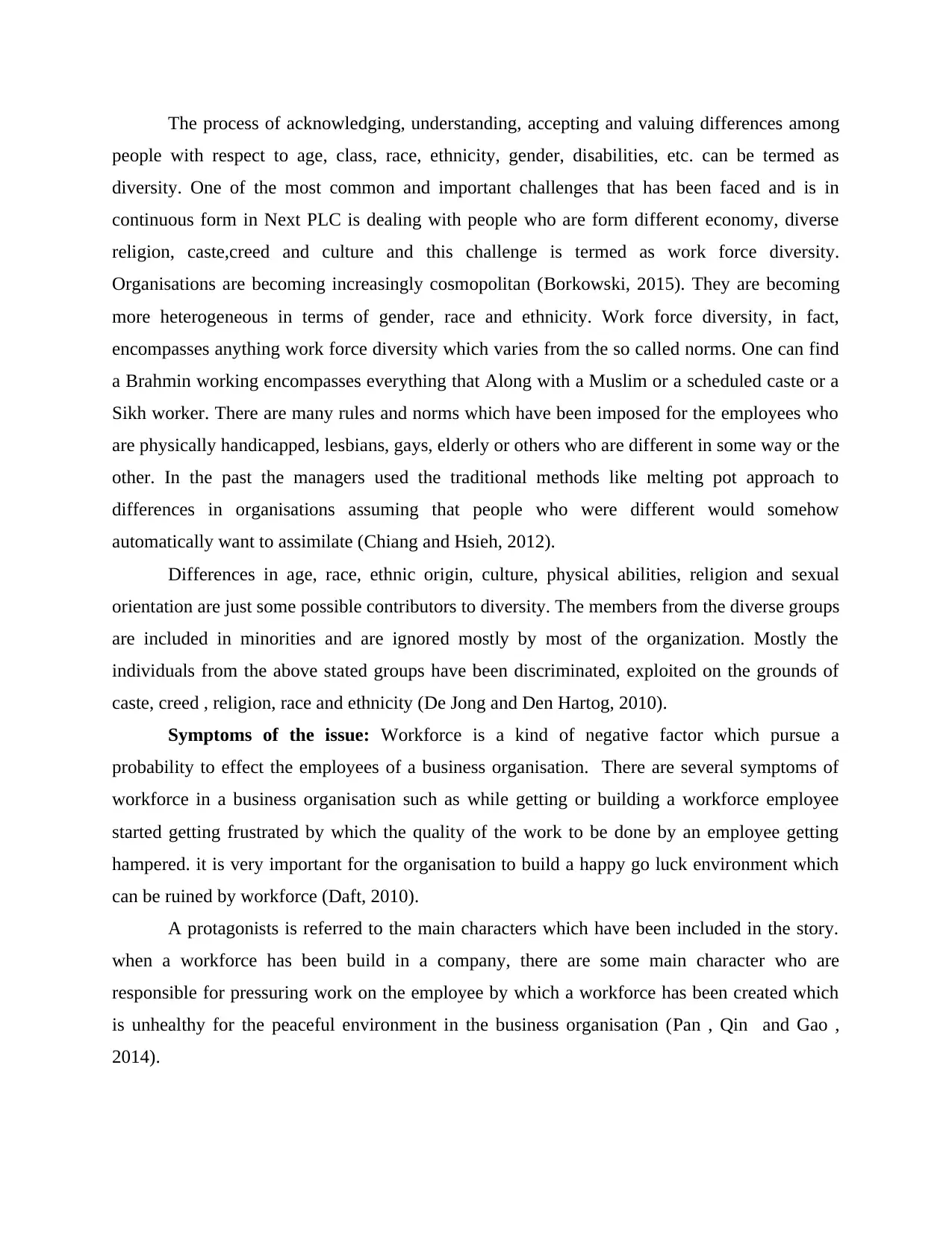
The process of acknowledging, understanding, accepting and valuing differences among
people with respect to age, class, race, ethnicity, gender, disabilities, etc. can be termed as
diversity. One of the most common and important challenges that has been faced and is in
continuous form in Next PLC is dealing with people who are form different economy, diverse
religion, caste,creed and culture and this challenge is termed as work force diversity.
Organisations are becoming increasingly cosmopolitan (Borkowski, 2015). They are becoming
more heterogeneous in terms of gender, race and ethnicity. Work force diversity, in fact,
encompasses anything work force diversity which varies from the so called norms. One can find
a Brahmin working encompasses everything that Along with a Muslim or a scheduled caste or a
Sikh worker. There are many rules and norms which have been imposed for the employees who
are physically handicapped, lesbians, gays, elderly or others who are different in some way or the
other. In the past the managers used the traditional methods like melting pot approach to
differences in organisations assuming that people who were different would somehow
automatically want to assimilate (Chiang and Hsieh, 2012).
Differences in age, race, ethnic origin, culture, physical abilities, religion and sexual
orientation are just some possible contributors to diversity. The members from the diverse groups
are included in minorities and are ignored mostly by most of the organization. Mostly the
individuals from the above stated groups have been discriminated, exploited on the grounds of
caste, creed , religion, race and ethnicity (De Jong and Den Hartog, 2010).
Symptoms of the issue: Workforce is a kind of negative factor which pursue a
probability to effect the employees of a business organisation. There are several symptoms of
workforce in a business organisation such as while getting or building a workforce employee
started getting frustrated by which the quality of the work to be done by an employee getting
hampered. it is very important for the organisation to build a happy go luck environment which
can be ruined by workforce (Daft, 2010).
A protagonists is referred to the main characters which have been included in the story.
when a workforce has been build in a company, there are some main character who are
responsible for pressuring work on the employee by which a workforce has been created which
is unhealthy for the peaceful environment in the business organisation (Pan , Qin and Gao ,
2014).
people with respect to age, class, race, ethnicity, gender, disabilities, etc. can be termed as
diversity. One of the most common and important challenges that has been faced and is in
continuous form in Next PLC is dealing with people who are form different economy, diverse
religion, caste,creed and culture and this challenge is termed as work force diversity.
Organisations are becoming increasingly cosmopolitan (Borkowski, 2015). They are becoming
more heterogeneous in terms of gender, race and ethnicity. Work force diversity, in fact,
encompasses anything work force diversity which varies from the so called norms. One can find
a Brahmin working encompasses everything that Along with a Muslim or a scheduled caste or a
Sikh worker. There are many rules and norms which have been imposed for the employees who
are physically handicapped, lesbians, gays, elderly or others who are different in some way or the
other. In the past the managers used the traditional methods like melting pot approach to
differences in organisations assuming that people who were different would somehow
automatically want to assimilate (Chiang and Hsieh, 2012).
Differences in age, race, ethnic origin, culture, physical abilities, religion and sexual
orientation are just some possible contributors to diversity. The members from the diverse groups
are included in minorities and are ignored mostly by most of the organization. Mostly the
individuals from the above stated groups have been discriminated, exploited on the grounds of
caste, creed , religion, race and ethnicity (De Jong and Den Hartog, 2010).
Symptoms of the issue: Workforce is a kind of negative factor which pursue a
probability to effect the employees of a business organisation. There are several symptoms of
workforce in a business organisation such as while getting or building a workforce employee
started getting frustrated by which the quality of the work to be done by an employee getting
hampered. it is very important for the organisation to build a happy go luck environment which
can be ruined by workforce (Daft, 2010).
A protagonists is referred to the main characters which have been included in the story.
when a workforce has been build in a company, there are some main character who are
responsible for pressuring work on the employee by which a workforce has been created which
is unhealthy for the peaceful environment in the business organisation (Pan , Qin and Gao ,
2014).
Paraphrase This Document
Need a fresh take? Get an instant paraphrase of this document with our AI Paraphraser
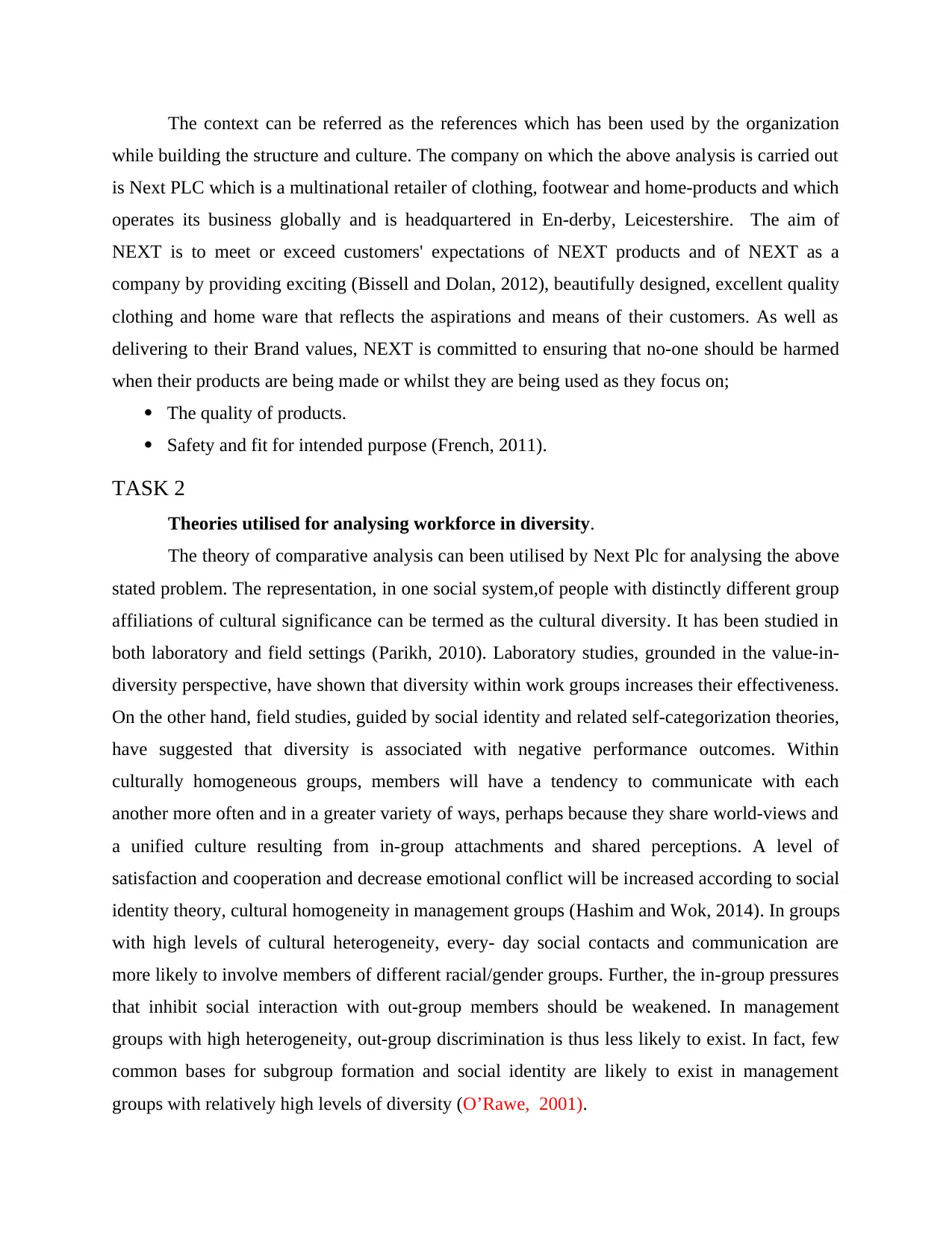
The context can be referred as the references which has been used by the organization
while building the structure and culture. The company on which the above analysis is carried out
is Next PLC which is a multinational retailer of clothing, footwear and home-products and which
operates its business globally and is headquartered in En-derby, Leicestershire. The aim of
NEXT is to meet or exceed customers' expectations of NEXT products and of NEXT as a
company by providing exciting (Bissell and Dolan, 2012), beautifully designed, excellent quality
clothing and home ware that reflects the aspirations and means of their customers. As well as
delivering to their Brand values, NEXT is committed to ensuring that no-one should be harmed
when their products are being made or whilst they are being used as they focus on;
The quality of products.
Safety and fit for intended purpose (French, 2011).
TASK 2
Theories utilised for analysing workforce in diversity.
The theory of comparative analysis can been utilised by Next Plc for analysing the above
stated problem. The representation, in one social system,of people with distinctly different group
affiliations of cultural significance can be termed as the cultural diversity. It has been studied in
both laboratory and field settings (Parikh, 2010). Laboratory studies, grounded in the value-in-
diversity perspective, have shown that diversity within work groups increases their effectiveness.
On the other hand, field studies, guided by social identity and related self-categorization theories,
have suggested that diversity is associated with negative performance outcomes. Within
culturally homogeneous groups, members will have a tendency to communicate with each
another more often and in a greater variety of ways, perhaps because they share world-views and
a unified culture resulting from in-group attachments and shared perceptions. A level of
satisfaction and cooperation and decrease emotional conflict will be increased according to social
identity theory, cultural homogeneity in management groups (Hashim and Wok, 2014). In groups
with high levels of cultural heterogeneity, every- day social contacts and communication are
more likely to involve members of different racial/gender groups. Further, the in-group pressures
that inhibit social interaction with out-group members should be weakened. In management
groups with high heterogeneity, out-group discrimination is thus less likely to exist. In fact, few
common bases for subgroup formation and social identity are likely to exist in management
groups with relatively high levels of diversity (O’Rawe, 2001).
while building the structure and culture. The company on which the above analysis is carried out
is Next PLC which is a multinational retailer of clothing, footwear and home-products and which
operates its business globally and is headquartered in En-derby, Leicestershire. The aim of
NEXT is to meet or exceed customers' expectations of NEXT products and of NEXT as a
company by providing exciting (Bissell and Dolan, 2012), beautifully designed, excellent quality
clothing and home ware that reflects the aspirations and means of their customers. As well as
delivering to their Brand values, NEXT is committed to ensuring that no-one should be harmed
when their products are being made or whilst they are being used as they focus on;
The quality of products.
Safety and fit for intended purpose (French, 2011).
TASK 2
Theories utilised for analysing workforce in diversity.
The theory of comparative analysis can been utilised by Next Plc for analysing the above
stated problem. The representation, in one social system,of people with distinctly different group
affiliations of cultural significance can be termed as the cultural diversity. It has been studied in
both laboratory and field settings (Parikh, 2010). Laboratory studies, grounded in the value-in-
diversity perspective, have shown that diversity within work groups increases their effectiveness.
On the other hand, field studies, guided by social identity and related self-categorization theories,
have suggested that diversity is associated with negative performance outcomes. Within
culturally homogeneous groups, members will have a tendency to communicate with each
another more often and in a greater variety of ways, perhaps because they share world-views and
a unified culture resulting from in-group attachments and shared perceptions. A level of
satisfaction and cooperation and decrease emotional conflict will be increased according to social
identity theory, cultural homogeneity in management groups (Hashim and Wok, 2014). In groups
with high levels of cultural heterogeneity, every- day social contacts and communication are
more likely to involve members of different racial/gender groups. Further, the in-group pressures
that inhibit social interaction with out-group members should be weakened. In management
groups with high heterogeneity, out-group discrimination is thus less likely to exist. In fact, few
common bases for subgroup formation and social identity are likely to exist in management
groups with relatively high levels of diversity (O’Rawe, 2001).
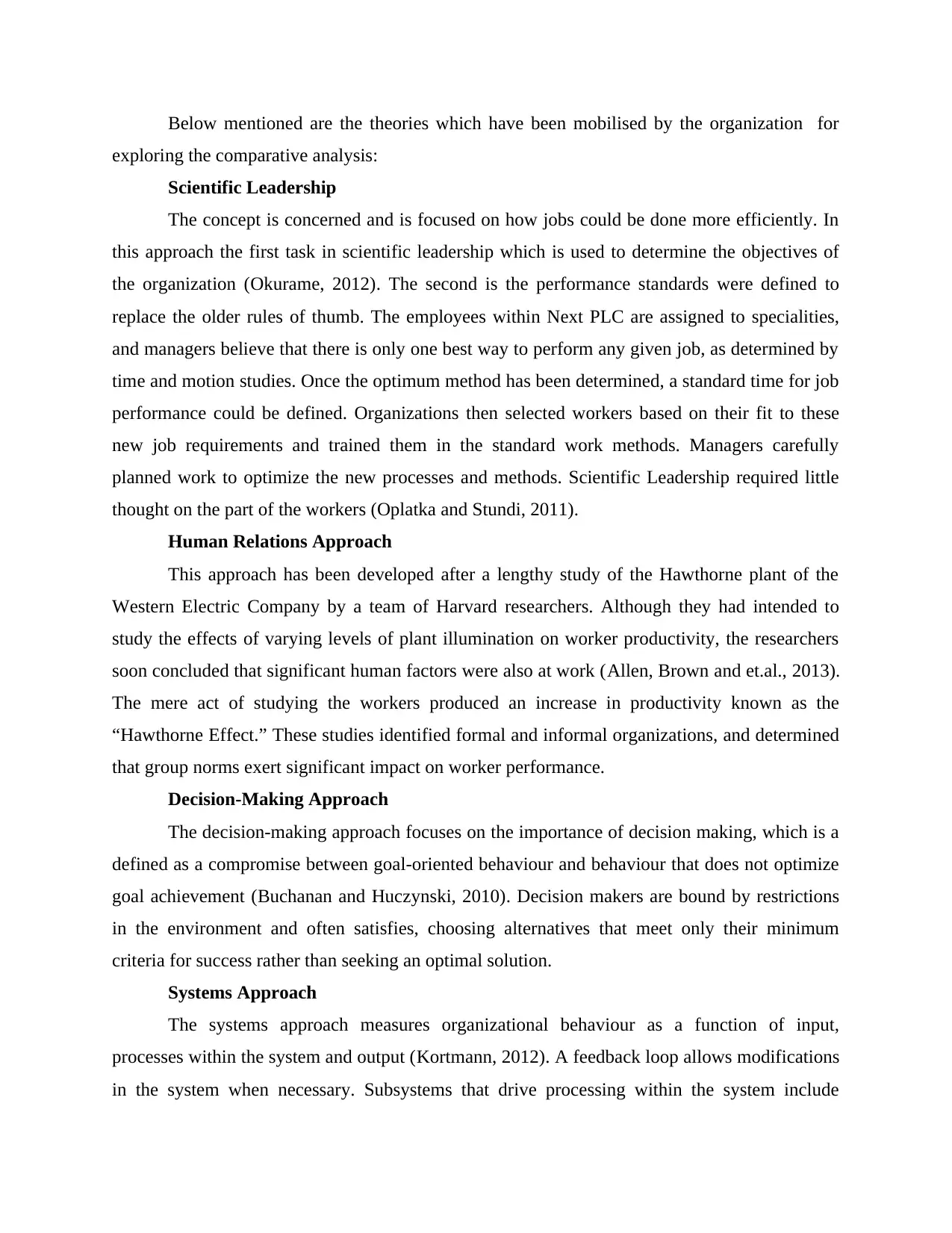
Below mentioned are the theories which have been mobilised by the organization for
exploring the comparative analysis:
Scientific Leadership
The concept is concerned and is focused on how jobs could be done more efficiently. In
this approach the first task in scientific leadership which is used to determine the objectives of
the organization (Okurame, 2012). The second is the performance standards were defined to
replace the older rules of thumb. The employees within Next PLC are assigned to specialities,
and managers believe that there is only one best way to perform any given job, as determined by
time and motion studies. Once the optimum method has been determined, a standard time for job
performance could be defined. Organizations then selected workers based on their fit to these
new job requirements and trained them in the standard work methods. Managers carefully
planned work to optimize the new processes and methods. Scientific Leadership required little
thought on the part of the workers (Oplatka and Stundi, 2011).
Human Relations Approach
This approach has been developed after a lengthy study of the Hawthorne plant of the
Western Electric Company by a team of Harvard researchers. Although they had intended to
study the effects of varying levels of plant illumination on worker productivity, the researchers
soon concluded that significant human factors were also at work (Allen, Brown and et.al., 2013).
The mere act of studying the workers produced an increase in productivity known as the
“Hawthorne Effect.” These studies identified formal and informal organizations, and determined
that group norms exert significant impact on worker performance.
Decision-Making Approach
The decision-making approach focuses on the importance of decision making, which is a
defined as a compromise between goal-oriented behaviour and behaviour that does not optimize
goal achievement (Buchanan and Huczynski, 2010). Decision makers are bound by restrictions
in the environment and often satisfies, choosing alternatives that meet only their minimum
criteria for success rather than seeking an optimal solution.
Systems Approach
The systems approach measures organizational behaviour as a function of input,
processes within the system and output (Kortmann, 2012). A feedback loop allows modifications
in the system when necessary. Subsystems that drive processing within the system include
exploring the comparative analysis:
Scientific Leadership
The concept is concerned and is focused on how jobs could be done more efficiently. In
this approach the first task in scientific leadership which is used to determine the objectives of
the organization (Okurame, 2012). The second is the performance standards were defined to
replace the older rules of thumb. The employees within Next PLC are assigned to specialities,
and managers believe that there is only one best way to perform any given job, as determined by
time and motion studies. Once the optimum method has been determined, a standard time for job
performance could be defined. Organizations then selected workers based on their fit to these
new job requirements and trained them in the standard work methods. Managers carefully
planned work to optimize the new processes and methods. Scientific Leadership required little
thought on the part of the workers (Oplatka and Stundi, 2011).
Human Relations Approach
This approach has been developed after a lengthy study of the Hawthorne plant of the
Western Electric Company by a team of Harvard researchers. Although they had intended to
study the effects of varying levels of plant illumination on worker productivity, the researchers
soon concluded that significant human factors were also at work (Allen, Brown and et.al., 2013).
The mere act of studying the workers produced an increase in productivity known as the
“Hawthorne Effect.” These studies identified formal and informal organizations, and determined
that group norms exert significant impact on worker performance.
Decision-Making Approach
The decision-making approach focuses on the importance of decision making, which is a
defined as a compromise between goal-oriented behaviour and behaviour that does not optimize
goal achievement (Buchanan and Huczynski, 2010). Decision makers are bound by restrictions
in the environment and often satisfies, choosing alternatives that meet only their minimum
criteria for success rather than seeking an optimal solution.
Systems Approach
The systems approach measures organizational behaviour as a function of input,
processes within the system and output (Kortmann, 2012). A feedback loop allows modifications
in the system when necessary. Subsystems that drive processing within the system include
⊘ This is a preview!⊘
Do you want full access?
Subscribe today to unlock all pages.

Trusted by 1+ million students worldwide
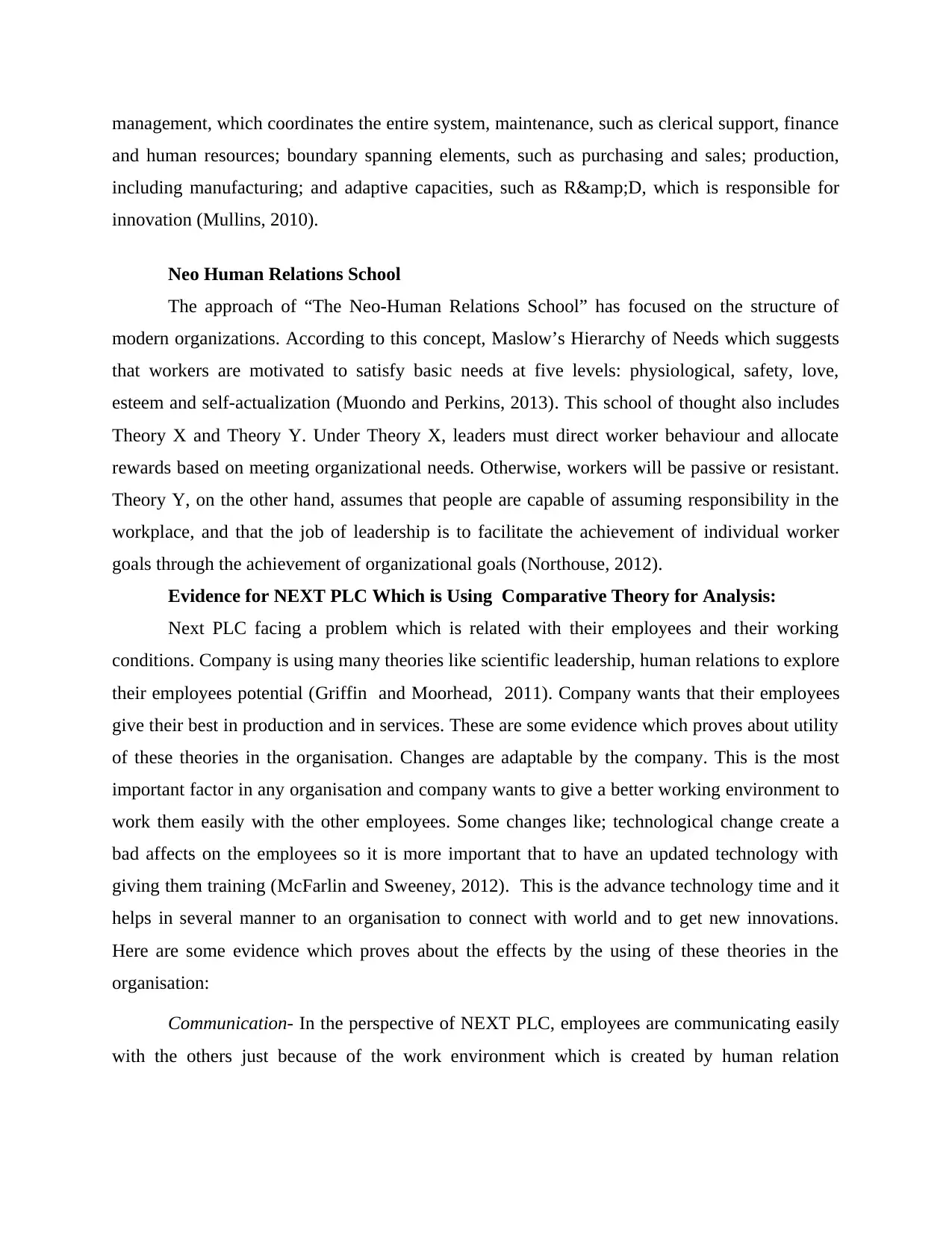
management, which coordinates the entire system, maintenance, such as clerical support, finance
and human resources; boundary spanning elements, such as purchasing and sales; production,
including manufacturing; and adaptive capacities, such as R&D, which is responsible for
innovation (Mullins, 2010).
Neo Human Relations School
The approach of “The Neo-Human Relations School” has focused on the structure of
modern organizations. According to this concept, Maslow’s Hierarchy of Needs which suggests
that workers are motivated to satisfy basic needs at five levels: physiological, safety, love,
esteem and self-actualization (Muondo and Perkins, 2013). This school of thought also includes
Theory X and Theory Y. Under Theory X, leaders must direct worker behaviour and allocate
rewards based on meeting organizational needs. Otherwise, workers will be passive or resistant.
Theory Y, on the other hand, assumes that people are capable of assuming responsibility in the
workplace, and that the job of leadership is to facilitate the achievement of individual worker
goals through the achievement of organizational goals (Northouse, 2012).
Evidence for NEXT PLC Which is Using Comparative Theory for Analysis:
Next PLC facing a problem which is related with their employees and their working
conditions. Company is using many theories like scientific leadership, human relations to explore
their employees potential (Griffin and Moorhead, 2011). Company wants that their employees
give their best in production and in services. These are some evidence which proves about utility
of these theories in the organisation. Changes are adaptable by the company. This is the most
important factor in any organisation and company wants to give a better working environment to
work them easily with the other employees. Some changes like; technological change create a
bad affects on the employees so it is more important that to have an updated technology with
giving them training (McFarlin and Sweeney, 2012). This is the advance technology time and it
helps in several manner to an organisation to connect with world and to get new innovations.
Here are some evidence which proves about the effects by the using of these theories in the
organisation:
Communication- In the perspective of NEXT PLC, employees are communicating easily
with the others just because of the work environment which is created by human relation
and human resources; boundary spanning elements, such as purchasing and sales; production,
including manufacturing; and adaptive capacities, such as R&D, which is responsible for
innovation (Mullins, 2010).
Neo Human Relations School
The approach of “The Neo-Human Relations School” has focused on the structure of
modern organizations. According to this concept, Maslow’s Hierarchy of Needs which suggests
that workers are motivated to satisfy basic needs at five levels: physiological, safety, love,
esteem and self-actualization (Muondo and Perkins, 2013). This school of thought also includes
Theory X and Theory Y. Under Theory X, leaders must direct worker behaviour and allocate
rewards based on meeting organizational needs. Otherwise, workers will be passive or resistant.
Theory Y, on the other hand, assumes that people are capable of assuming responsibility in the
workplace, and that the job of leadership is to facilitate the achievement of individual worker
goals through the achievement of organizational goals (Northouse, 2012).
Evidence for NEXT PLC Which is Using Comparative Theory for Analysis:
Next PLC facing a problem which is related with their employees and their working
conditions. Company is using many theories like scientific leadership, human relations to explore
their employees potential (Griffin and Moorhead, 2011). Company wants that their employees
give their best in production and in services. These are some evidence which proves about utility
of these theories in the organisation. Changes are adaptable by the company. This is the most
important factor in any organisation and company wants to give a better working environment to
work them easily with the other employees. Some changes like; technological change create a
bad affects on the employees so it is more important that to have an updated technology with
giving them training (McFarlin and Sweeney, 2012). This is the advance technology time and it
helps in several manner to an organisation to connect with world and to get new innovations.
Here are some evidence which proves about the effects by the using of these theories in the
organisation:
Communication- In the perspective of NEXT PLC, employees are communicating easily
with the others just because of the work environment which is created by human relation
Paraphrase This Document
Need a fresh take? Get an instant paraphrase of this document with our AI Paraphraser
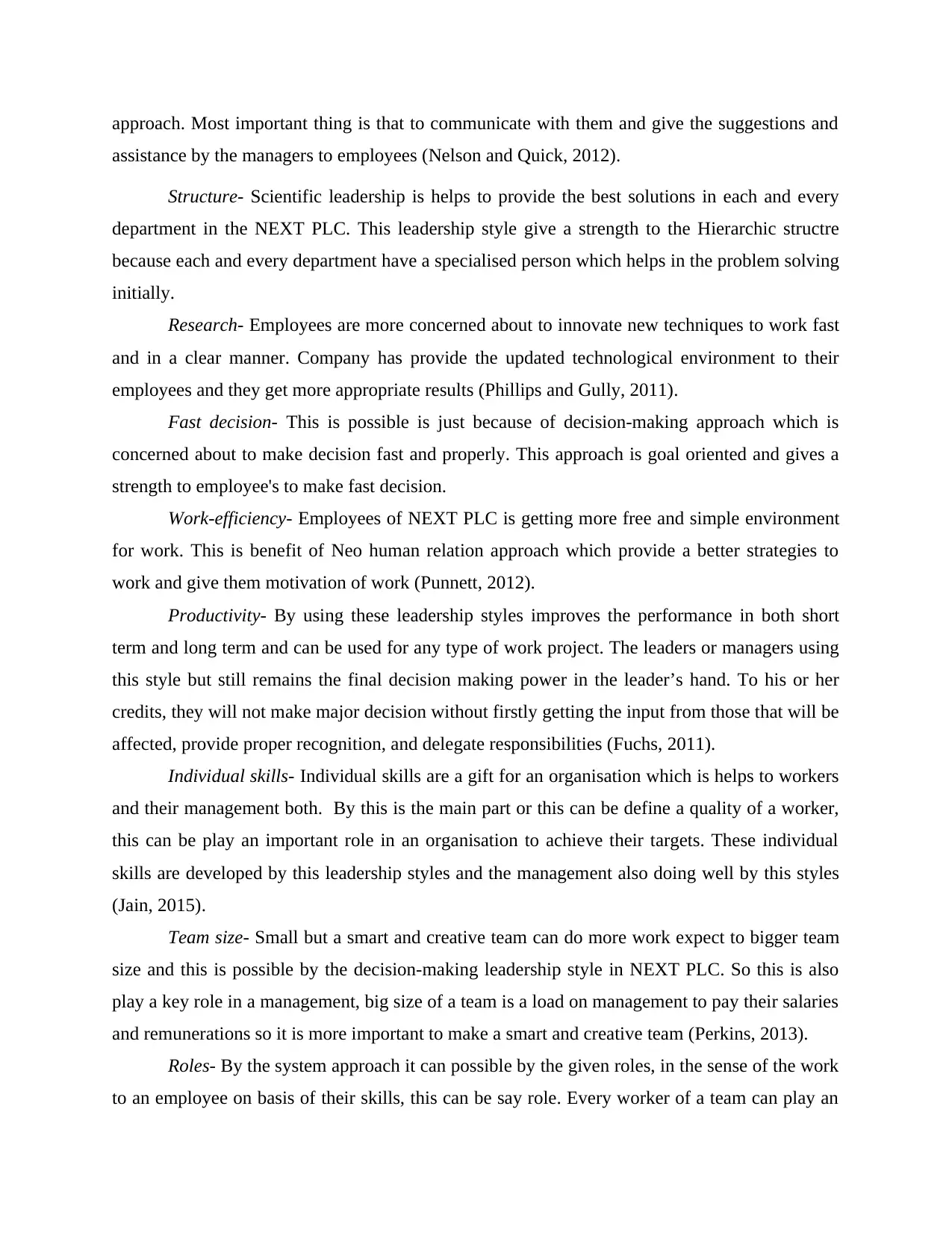
approach. Most important thing is that to communicate with them and give the suggestions and
assistance by the managers to employees (Nelson and Quick, 2012).
Structure- Scientific leadership is helps to provide the best solutions in each and every
department in the NEXT PLC. This leadership style give a strength to the Hierarchic structre
because each and every department have a specialised person which helps in the problem solving
initially.
Research- Employees are more concerned about to innovate new techniques to work fast
and in a clear manner. Company has provide the updated technological environment to their
employees and they get more appropriate results (Phillips and Gully, 2011).
Fast decision- This is possible is just because of decision-making approach which is
concerned about to make decision fast and properly. This approach is goal oriented and gives a
strength to employee's to make fast decision.
Work-efficiency- Employees of NEXT PLC is getting more free and simple environment
for work. This is benefit of Neo human relation approach which provide a better strategies to
work and give them motivation of work (Punnett, 2012).
Productivity- By using these leadership styles improves the performance in both short
term and long term and can be used for any type of work project. The leaders or managers using
this style but still remains the final decision making power in the leader’s hand. To his or her
credits, they will not make major decision without firstly getting the input from those that will be
affected, provide proper recognition, and delegate responsibilities (Fuchs, 2011).
Individual skills- Individual skills are a gift for an organisation which is helps to workers
and their management both. By this is the main part or this can be define a quality of a worker,
this can be play an important role in an organisation to achieve their targets. These individual
skills are developed by this leadership styles and the management also doing well by this styles
(Jain, 2015).
Team size- Small but a smart and creative team can do more work expect to bigger team
size and this is possible by the decision-making leadership style in NEXT PLC. So this is also
play a key role in a management, big size of a team is a load on management to pay their salaries
and remunerations so it is more important to make a smart and creative team (Perkins, 2013).
Roles- By the system approach it can possible by the given roles, in the sense of the work
to an employee on basis of their skills, this can be say role. Every worker of a team can play an
assistance by the managers to employees (Nelson and Quick, 2012).
Structure- Scientific leadership is helps to provide the best solutions in each and every
department in the NEXT PLC. This leadership style give a strength to the Hierarchic structre
because each and every department have a specialised person which helps in the problem solving
initially.
Research- Employees are more concerned about to innovate new techniques to work fast
and in a clear manner. Company has provide the updated technological environment to their
employees and they get more appropriate results (Phillips and Gully, 2011).
Fast decision- This is possible is just because of decision-making approach which is
concerned about to make decision fast and properly. This approach is goal oriented and gives a
strength to employee's to make fast decision.
Work-efficiency- Employees of NEXT PLC is getting more free and simple environment
for work. This is benefit of Neo human relation approach which provide a better strategies to
work and give them motivation of work (Punnett, 2012).
Productivity- By using these leadership styles improves the performance in both short
term and long term and can be used for any type of work project. The leaders or managers using
this style but still remains the final decision making power in the leader’s hand. To his or her
credits, they will not make major decision without firstly getting the input from those that will be
affected, provide proper recognition, and delegate responsibilities (Fuchs, 2011).
Individual skills- Individual skills are a gift for an organisation which is helps to workers
and their management both. By this is the main part or this can be define a quality of a worker,
this can be play an important role in an organisation to achieve their targets. These individual
skills are developed by this leadership styles and the management also doing well by this styles
(Jain, 2015).
Team size- Small but a smart and creative team can do more work expect to bigger team
size and this is possible by the decision-making leadership style in NEXT PLC. So this is also
play a key role in a management, big size of a team is a load on management to pay their salaries
and remunerations so it is more important to make a smart and creative team (Perkins, 2013).
Roles- By the system approach it can possible by the given roles, in the sense of the work
to an employee on basis of their skills, this can be say role. Every worker of a team can play an
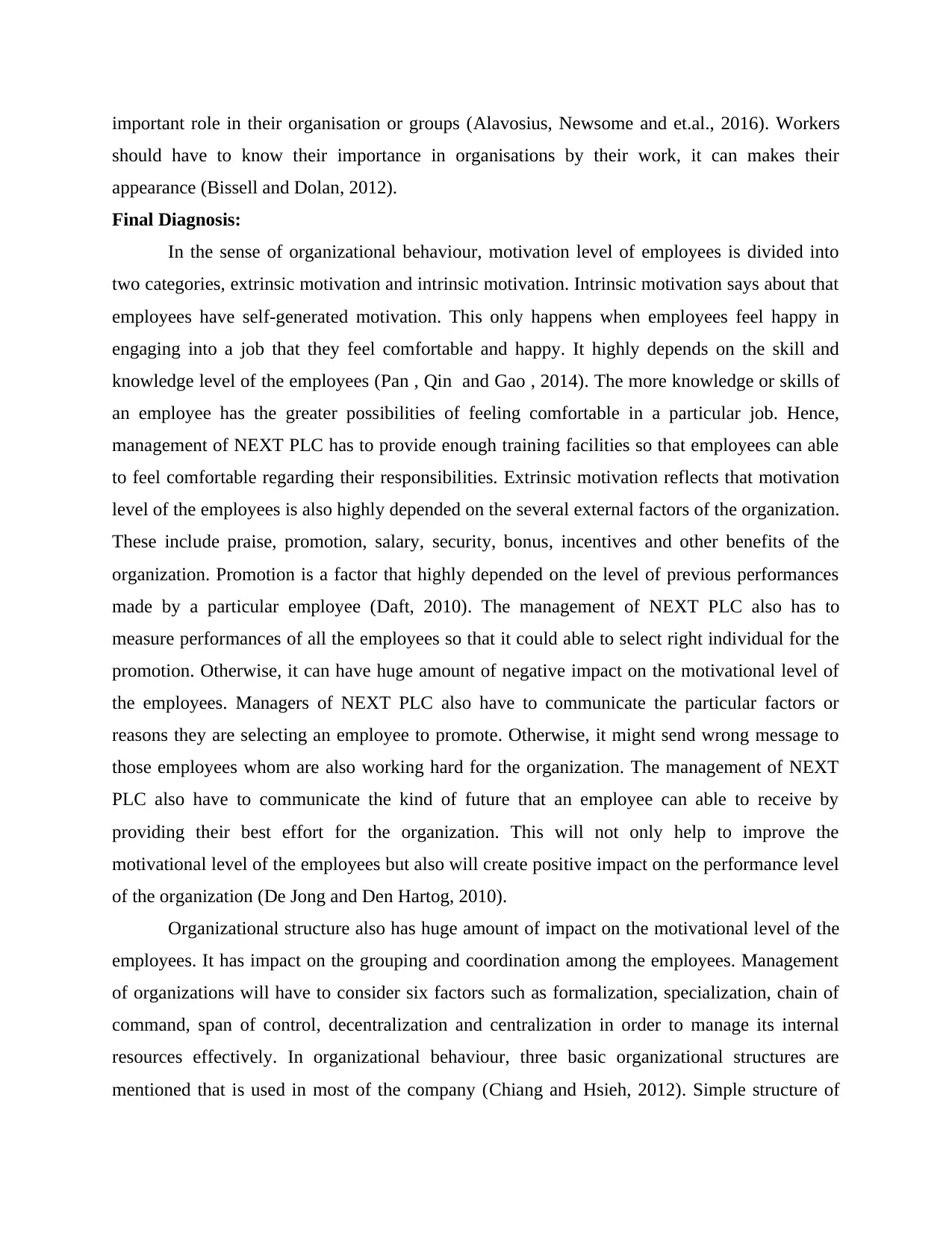
important role in their organisation or groups (Alavosius, Newsome and et.al., 2016). Workers
should have to know their importance in organisations by their work, it can makes their
appearance (Bissell and Dolan, 2012).
Final Diagnosis:
In the sense of organizational behaviour, motivation level of employees is divided into
two categories, extrinsic motivation and intrinsic motivation. Intrinsic motivation says about that
employees have self-generated motivation. This only happens when employees feel happy in
engaging into a job that they feel comfortable and happy. It highly depends on the skill and
knowledge level of the employees (Pan , Qin and Gao , 2014). The more knowledge or skills of
an employee has the greater possibilities of feeling comfortable in a particular job. Hence,
management of NEXT PLC has to provide enough training facilities so that employees can able
to feel comfortable regarding their responsibilities. Extrinsic motivation reflects that motivation
level of the employees is also highly depended on the several external factors of the organization.
These include praise, promotion, salary, security, bonus, incentives and other benefits of the
organization. Promotion is a factor that highly depended on the level of previous performances
made by a particular employee (Daft, 2010). The management of NEXT PLC also has to
measure performances of all the employees so that it could able to select right individual for the
promotion. Otherwise, it can have huge amount of negative impact on the motivational level of
the employees. Managers of NEXT PLC also have to communicate the particular factors or
reasons they are selecting an employee to promote. Otherwise, it might send wrong message to
those employees whom are also working hard for the organization. The management of NEXT
PLC also have to communicate the kind of future that an employee can able to receive by
providing their best effort for the organization. This will not only help to improve the
motivational level of the employees but also will create positive impact on the performance level
of the organization (De Jong and Den Hartog, 2010).
Organizational structure also has huge amount of impact on the motivational level of the
employees. It has impact on the grouping and coordination among the employees. Management
of organizations will have to consider six factors such as formalization, specialization, chain of
command, span of control, decentralization and centralization in order to manage its internal
resources effectively. In organizational behaviour, three basic organizational structures are
mentioned that is used in most of the company (Chiang and Hsieh, 2012). Simple structure of
should have to know their importance in organisations by their work, it can makes their
appearance (Bissell and Dolan, 2012).
Final Diagnosis:
In the sense of organizational behaviour, motivation level of employees is divided into
two categories, extrinsic motivation and intrinsic motivation. Intrinsic motivation says about that
employees have self-generated motivation. This only happens when employees feel happy in
engaging into a job that they feel comfortable and happy. It highly depends on the skill and
knowledge level of the employees (Pan , Qin and Gao , 2014). The more knowledge or skills of
an employee has the greater possibilities of feeling comfortable in a particular job. Hence,
management of NEXT PLC has to provide enough training facilities so that employees can able
to feel comfortable regarding their responsibilities. Extrinsic motivation reflects that motivation
level of the employees is also highly depended on the several external factors of the organization.
These include praise, promotion, salary, security, bonus, incentives and other benefits of the
organization. Promotion is a factor that highly depended on the level of previous performances
made by a particular employee (Daft, 2010). The management of NEXT PLC also has to
measure performances of all the employees so that it could able to select right individual for the
promotion. Otherwise, it can have huge amount of negative impact on the motivational level of
the employees. Managers of NEXT PLC also have to communicate the particular factors or
reasons they are selecting an employee to promote. Otherwise, it might send wrong message to
those employees whom are also working hard for the organization. The management of NEXT
PLC also have to communicate the kind of future that an employee can able to receive by
providing their best effort for the organization. This will not only help to improve the
motivational level of the employees but also will create positive impact on the performance level
of the organization (De Jong and Den Hartog, 2010).
Organizational structure also has huge amount of impact on the motivational level of the
employees. It has impact on the grouping and coordination among the employees. Management
of organizations will have to consider six factors such as formalization, specialization, chain of
command, span of control, decentralization and centralization in order to manage its internal
resources effectively. In organizational behaviour, three basic organizational structures are
mentioned that is used in most of the company (Chiang and Hsieh, 2012). Simple structure of
⊘ This is a preview!⊘
Do you want full access?
Subscribe today to unlock all pages.

Trusted by 1+ million students worldwide
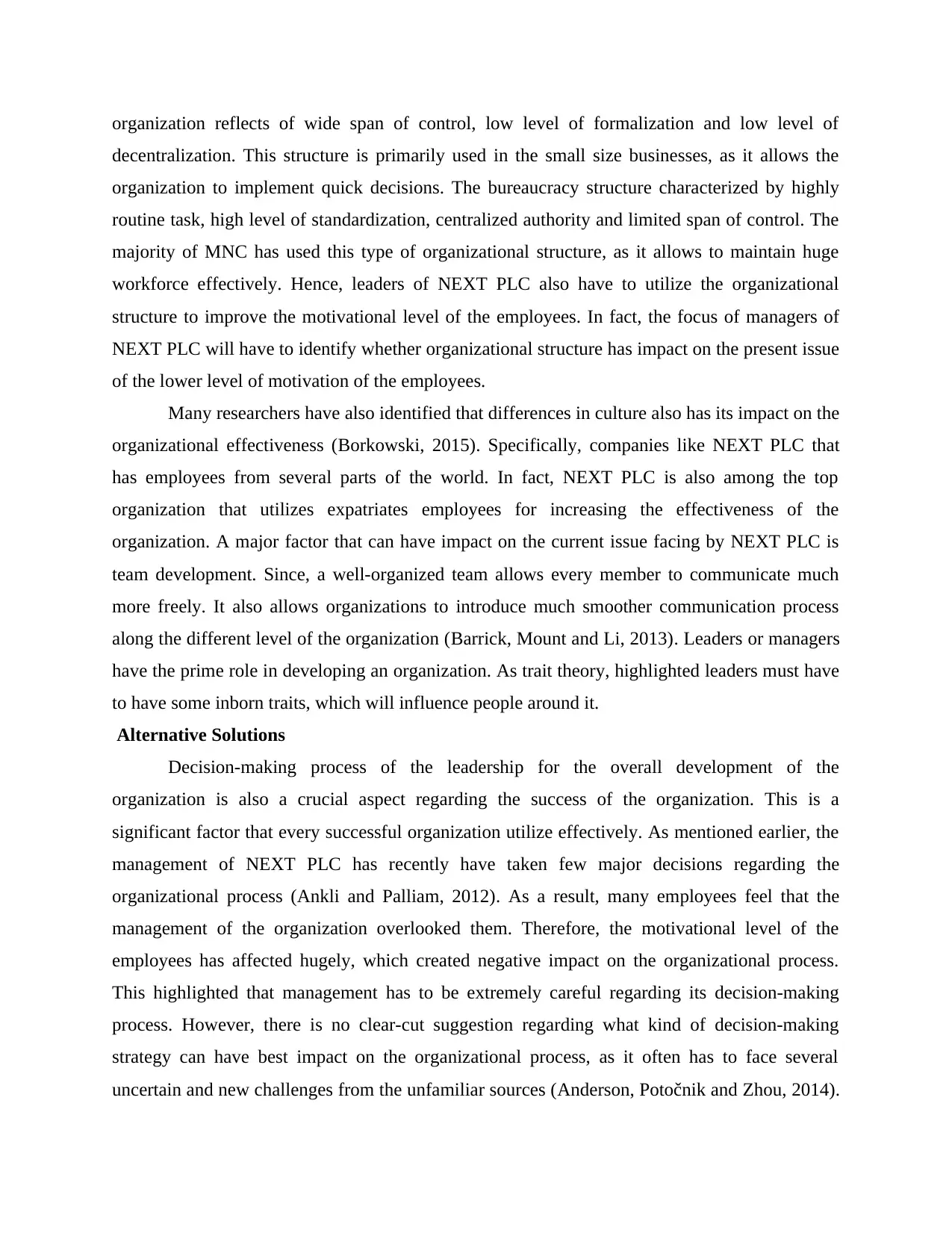
organization reflects of wide span of control, low level of formalization and low level of
decentralization. This structure is primarily used in the small size businesses, as it allows the
organization to implement quick decisions. The bureaucracy structure characterized by highly
routine task, high level of standardization, centralized authority and limited span of control. The
majority of MNC has used this type of organizational structure, as it allows to maintain huge
workforce effectively. Hence, leaders of NEXT PLC also have to utilize the organizational
structure to improve the motivational level of the employees. In fact, the focus of managers of
NEXT PLC will have to identify whether organizational structure has impact on the present issue
of the lower level of motivation of the employees.
Many researchers have also identified that differences in culture also has its impact on the
organizational effectiveness (Borkowski, 2015). Specifically, companies like NEXT PLC that
has employees from several parts of the world. In fact, NEXT PLC is also among the top
organization that utilizes expatriates employees for increasing the effectiveness of the
organization. A major factor that can have impact on the current issue facing by NEXT PLC is
team development. Since, a well-organized team allows every member to communicate much
more freely. It also allows organizations to introduce much smoother communication process
along the different level of the organization (Barrick, Mount and Li, 2013). Leaders or managers
have the prime role in developing an organization. As trait theory, highlighted leaders must have
to have some inborn traits, which will influence people around it.
Alternative Solutions
Decision-making process of the leadership for the overall development of the
organization is also a crucial aspect regarding the success of the organization. This is a
significant factor that every successful organization utilize effectively. As mentioned earlier, the
management of NEXT PLC has recently have taken few major decisions regarding the
organizational process (Ankli and Palliam, 2012). As a result, many employees feel that the
management of the organization overlooked them. Therefore, the motivational level of the
employees has affected hugely, which created negative impact on the organizational process.
This highlighted that management has to be extremely careful regarding its decision-making
process. However, there is no clear-cut suggestion regarding what kind of decision-making
strategy can have best impact on the organizational process, as it often has to face several
uncertain and new challenges from the unfamiliar sources (Anderson, Potočnik and Zhou, 2014).
decentralization. This structure is primarily used in the small size businesses, as it allows the
organization to implement quick decisions. The bureaucracy structure characterized by highly
routine task, high level of standardization, centralized authority and limited span of control. The
majority of MNC has used this type of organizational structure, as it allows to maintain huge
workforce effectively. Hence, leaders of NEXT PLC also have to utilize the organizational
structure to improve the motivational level of the employees. In fact, the focus of managers of
NEXT PLC will have to identify whether organizational structure has impact on the present issue
of the lower level of motivation of the employees.
Many researchers have also identified that differences in culture also has its impact on the
organizational effectiveness (Borkowski, 2015). Specifically, companies like NEXT PLC that
has employees from several parts of the world. In fact, NEXT PLC is also among the top
organization that utilizes expatriates employees for increasing the effectiveness of the
organization. A major factor that can have impact on the current issue facing by NEXT PLC is
team development. Since, a well-organized team allows every member to communicate much
more freely. It also allows organizations to introduce much smoother communication process
along the different level of the organization (Barrick, Mount and Li, 2013). Leaders or managers
have the prime role in developing an organization. As trait theory, highlighted leaders must have
to have some inborn traits, which will influence people around it.
Alternative Solutions
Decision-making process of the leadership for the overall development of the
organization is also a crucial aspect regarding the success of the organization. This is a
significant factor that every successful organization utilize effectively. As mentioned earlier, the
management of NEXT PLC has recently have taken few major decisions regarding the
organizational process (Ankli and Palliam, 2012). As a result, many employees feel that the
management of the organization overlooked them. Therefore, the motivational level of the
employees has affected hugely, which created negative impact on the organizational process.
This highlighted that management has to be extremely careful regarding its decision-making
process. However, there is no clear-cut suggestion regarding what kind of decision-making
strategy can have best impact on the organizational process, as it often has to face several
uncertain and new challenges from the unfamiliar sources (Anderson, Potočnik and Zhou, 2014).
Paraphrase This Document
Need a fresh take? Get an instant paraphrase of this document with our AI Paraphraser
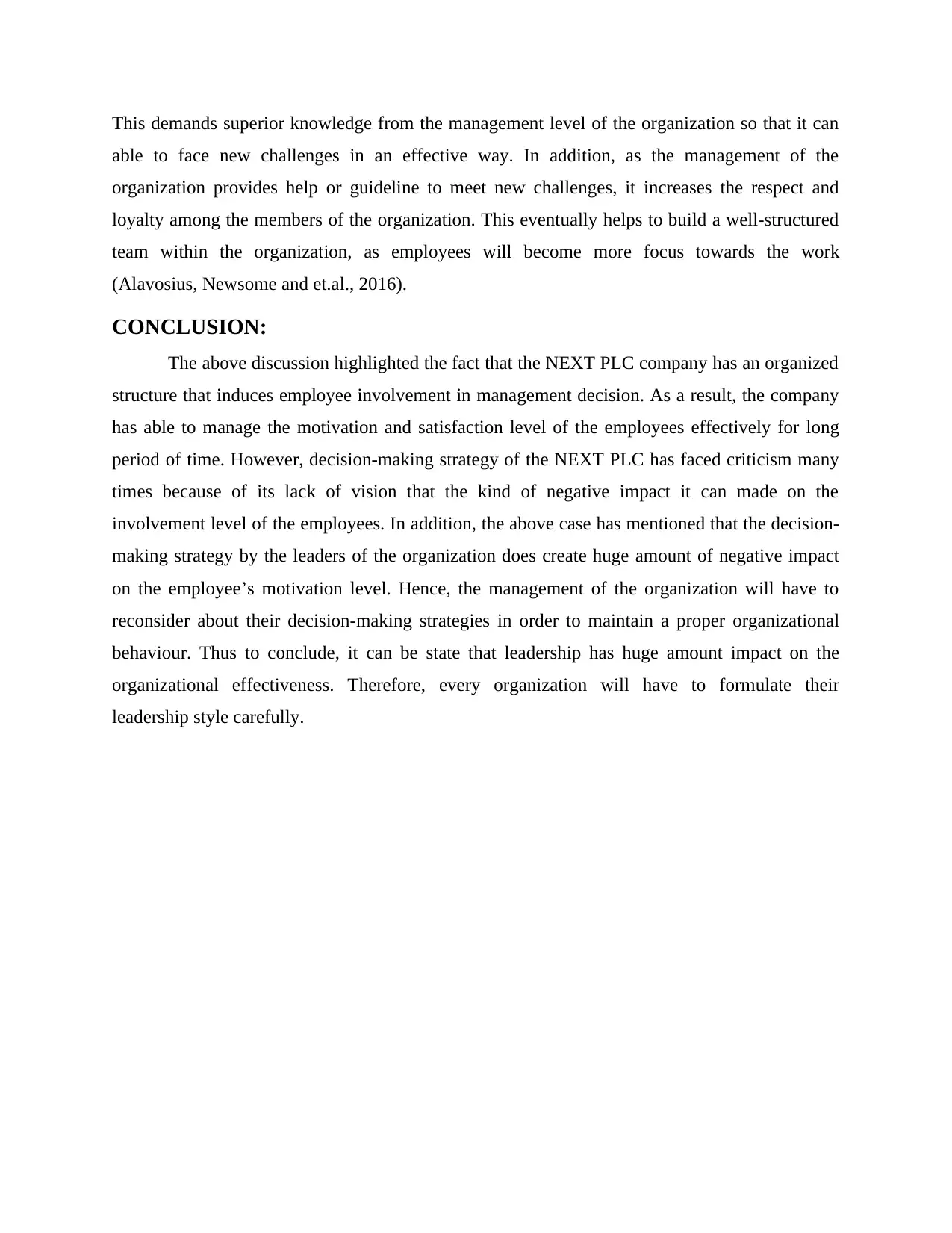
This demands superior knowledge from the management level of the organization so that it can
able to face new challenges in an effective way. In addition, as the management of the
organization provides help or guideline to meet new challenges, it increases the respect and
loyalty among the members of the organization. This eventually helps to build a well-structured
team within the organization, as employees will become more focus towards the work
(Alavosius, Newsome and et.al., 2016).
CONCLUSION:
The above discussion highlighted the fact that the NEXT PLC company has an organized
structure that induces employee involvement in management decision. As a result, the company
has able to manage the motivation and satisfaction level of the employees effectively for long
period of time. However, decision-making strategy of the NEXT PLC has faced criticism many
times because of its lack of vision that the kind of negative impact it can made on the
involvement level of the employees. In addition, the above case has mentioned that the decision-
making strategy by the leaders of the organization does create huge amount of negative impact
on the employee’s motivation level. Hence, the management of the organization will have to
reconsider about their decision-making strategies in order to maintain a proper organizational
behaviour. Thus to conclude, it can be state that leadership has huge amount impact on the
organizational effectiveness. Therefore, every organization will have to formulate their
leadership style carefully.
able to face new challenges in an effective way. In addition, as the management of the
organization provides help or guideline to meet new challenges, it increases the respect and
loyalty among the members of the organization. This eventually helps to build a well-structured
team within the organization, as employees will become more focus towards the work
(Alavosius, Newsome and et.al., 2016).
CONCLUSION:
The above discussion highlighted the fact that the NEXT PLC company has an organized
structure that induces employee involvement in management decision. As a result, the company
has able to manage the motivation and satisfaction level of the employees effectively for long
period of time. However, decision-making strategy of the NEXT PLC has faced criticism many
times because of its lack of vision that the kind of negative impact it can made on the
involvement level of the employees. In addition, the above case has mentioned that the decision-
making strategy by the leaders of the organization does create huge amount of negative impact
on the employee’s motivation level. Hence, the management of the organization will have to
reconsider about their decision-making strategies in order to maintain a proper organizational
behaviour. Thus to conclude, it can be state that leadership has huge amount impact on the
organizational effectiveness. Therefore, every organization will have to formulate their
leadership style carefully.
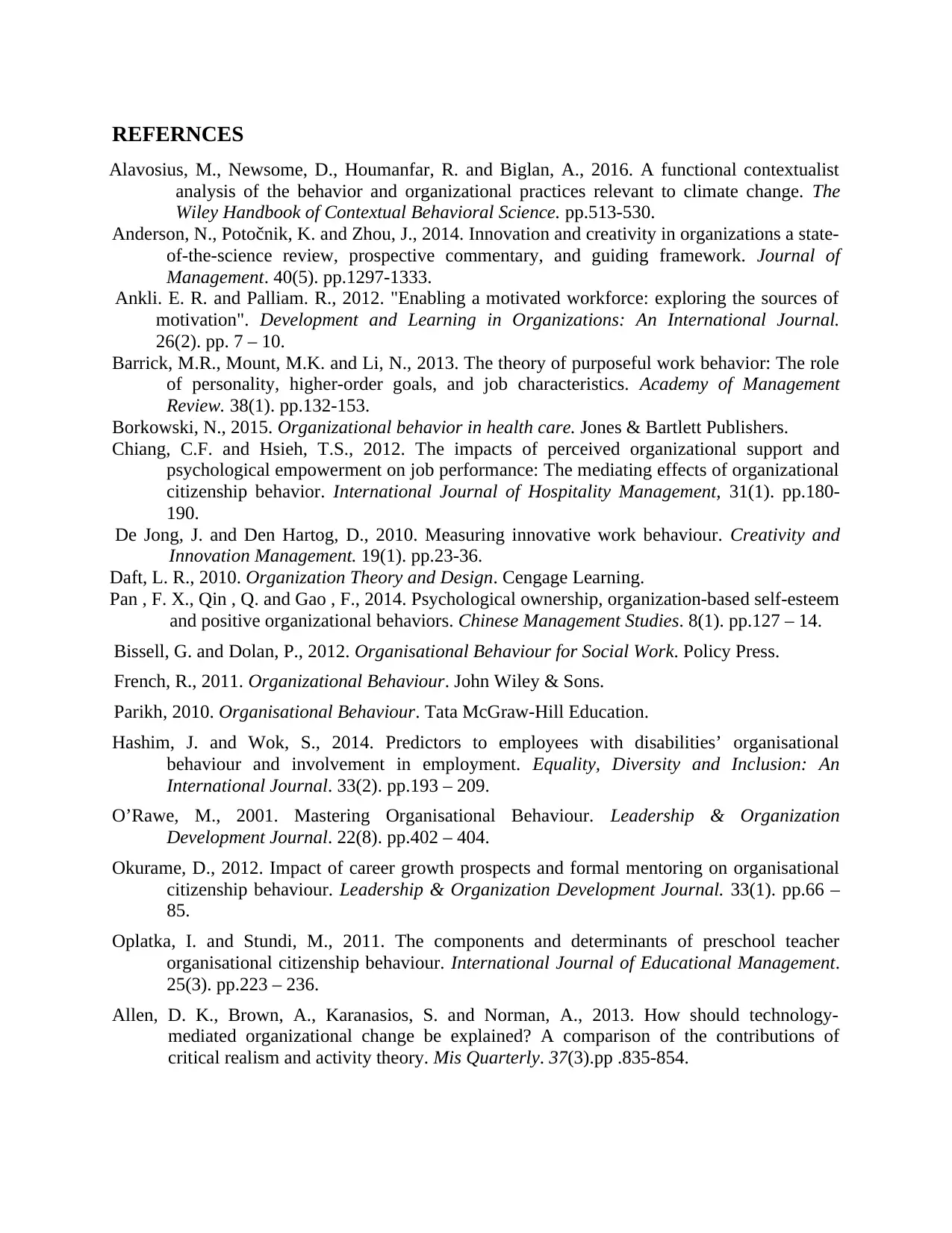
REFERNCES
Alavosius, M., Newsome, D., Houmanfar, R. and Biglan, A., 2016. A functional contextualist
analysis of the behavior and organizational practices relevant to climate change. The
Wiley Handbook of Contextual Behavioral Science. pp.513-530.
Anderson, N., Potočnik, K. and Zhou, J., 2014. Innovation and creativity in organizations a state-
of-the-science review, prospective commentary, and guiding framework. Journal of
Management. 40(5). pp.1297-1333.
Ankli. E. R. and Palliam. R., 2012. "Enabling a motivated workforce: exploring the sources of
motivation". Development and Learning in Organizations: An International Journal.
26(2). pp. 7 – 10.
Barrick, M.R., Mount, M.K. and Li, N., 2013. The theory of purposeful work behavior: The role
of personality, higher-order goals, and job characteristics. Academy of Management
Review. 38(1). pp.132-153.
Borkowski, N., 2015. Organizational behavior in health care. Jones & Bartlett Publishers.
Chiang, C.F. and Hsieh, T.S., 2012. The impacts of perceived organizational support and
psychological empowerment on job performance: The mediating effects of organizational
citizenship behavior. International Journal of Hospitality Management, 31(1). pp.180-
190.
De Jong, J. and Den Hartog, D., 2010. Measuring innovative work behaviour. Creativity and
Innovation Management. 19(1). pp.23-36.
Daft, L. R., 2010. Organization Theory and Design. Cengage Learning.
Pan , F. X., Qin , Q. and Gao , F., 2014. Psychological ownership, organization-based self-esteem
and positive organizational behaviors. Chinese Management Studies. 8(1). pp.127 – 14.
Bissell, G. and Dolan, P., 2012. Organisational Behaviour for Social Work. Policy Press.
French, R., 2011. Organizational Behaviour. John Wiley & Sons.
Parikh, 2010. Organisational Behaviour. Tata McGraw-Hill Education.
Hashim, J. and Wok, S., 2014. Predictors to employees with disabilities’ organisational
behaviour and involvement in employment. Equality, Diversity and Inclusion: An
International Journal. 33(2). pp.193 – 209.
O’Rawe, M., 2001. Mastering Organisational Behaviour. Leadership & Organization
Development Journal. 22(8). pp.402 – 404.
Okurame, D., 2012. Impact of career growth prospects and formal mentoring on organisational
citizenship behaviour. Leadership & Organization Development Journal. 33(1). pp.66 –
85.
Oplatka, I. and Stundi, M., 2011. The components and determinants of preschool teacher
organisational citizenship behaviour. International Journal of Educational Management.
25(3). pp.223 – 236.
Allen, D. K., Brown, A., Karanasios, S. and Norman, A., 2013. How should technology-
mediated organizational change be explained? A comparison of the contributions of
critical realism and activity theory. Mis Quarterly. 37(3).pp .835-854.
Alavosius, M., Newsome, D., Houmanfar, R. and Biglan, A., 2016. A functional contextualist
analysis of the behavior and organizational practices relevant to climate change. The
Wiley Handbook of Contextual Behavioral Science. pp.513-530.
Anderson, N., Potočnik, K. and Zhou, J., 2014. Innovation and creativity in organizations a state-
of-the-science review, prospective commentary, and guiding framework. Journal of
Management. 40(5). pp.1297-1333.
Ankli. E. R. and Palliam. R., 2012. "Enabling a motivated workforce: exploring the sources of
motivation". Development and Learning in Organizations: An International Journal.
26(2). pp. 7 – 10.
Barrick, M.R., Mount, M.K. and Li, N., 2013. The theory of purposeful work behavior: The role
of personality, higher-order goals, and job characteristics. Academy of Management
Review. 38(1). pp.132-153.
Borkowski, N., 2015. Organizational behavior in health care. Jones & Bartlett Publishers.
Chiang, C.F. and Hsieh, T.S., 2012. The impacts of perceived organizational support and
psychological empowerment on job performance: The mediating effects of organizational
citizenship behavior. International Journal of Hospitality Management, 31(1). pp.180-
190.
De Jong, J. and Den Hartog, D., 2010. Measuring innovative work behaviour. Creativity and
Innovation Management. 19(1). pp.23-36.
Daft, L. R., 2010. Organization Theory and Design. Cengage Learning.
Pan , F. X., Qin , Q. and Gao , F., 2014. Psychological ownership, organization-based self-esteem
and positive organizational behaviors. Chinese Management Studies. 8(1). pp.127 – 14.
Bissell, G. and Dolan, P., 2012. Organisational Behaviour for Social Work. Policy Press.
French, R., 2011. Organizational Behaviour. John Wiley & Sons.
Parikh, 2010. Organisational Behaviour. Tata McGraw-Hill Education.
Hashim, J. and Wok, S., 2014. Predictors to employees with disabilities’ organisational
behaviour and involvement in employment. Equality, Diversity and Inclusion: An
International Journal. 33(2). pp.193 – 209.
O’Rawe, M., 2001. Mastering Organisational Behaviour. Leadership & Organization
Development Journal. 22(8). pp.402 – 404.
Okurame, D., 2012. Impact of career growth prospects and formal mentoring on organisational
citizenship behaviour. Leadership & Organization Development Journal. 33(1). pp.66 –
85.
Oplatka, I. and Stundi, M., 2011. The components and determinants of preschool teacher
organisational citizenship behaviour. International Journal of Educational Management.
25(3). pp.223 – 236.
Allen, D. K., Brown, A., Karanasios, S. and Norman, A., 2013. How should technology-
mediated organizational change be explained? A comparison of the contributions of
critical realism and activity theory. Mis Quarterly. 37(3).pp .835-854.
⊘ This is a preview!⊘
Do you want full access?
Subscribe today to unlock all pages.

Trusted by 1+ million students worldwide
1 out of 14
Related Documents
Your All-in-One AI-Powered Toolkit for Academic Success.
+13062052269
info@desklib.com
Available 24*7 on WhatsApp / Email
![[object Object]](/_next/static/media/star-bottom.7253800d.svg)
Unlock your academic potential
Copyright © 2020–2025 A2Z Services. All Rights Reserved. Developed and managed by ZUCOL.




